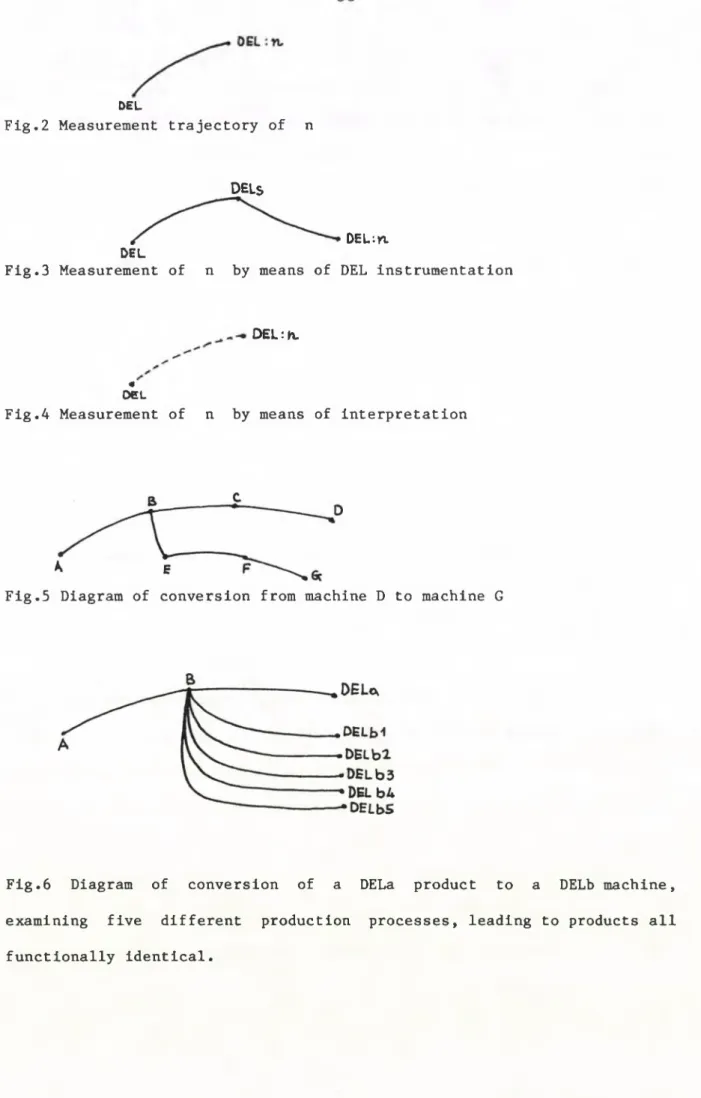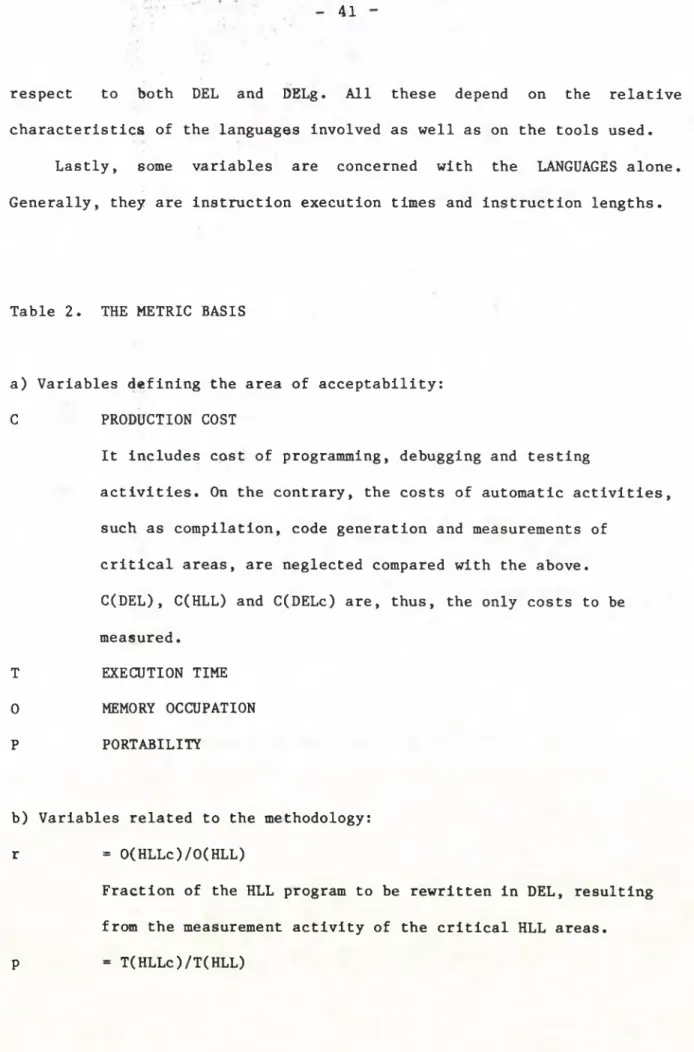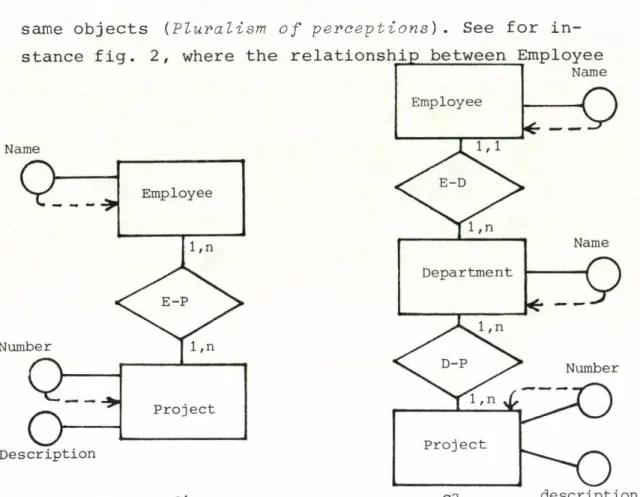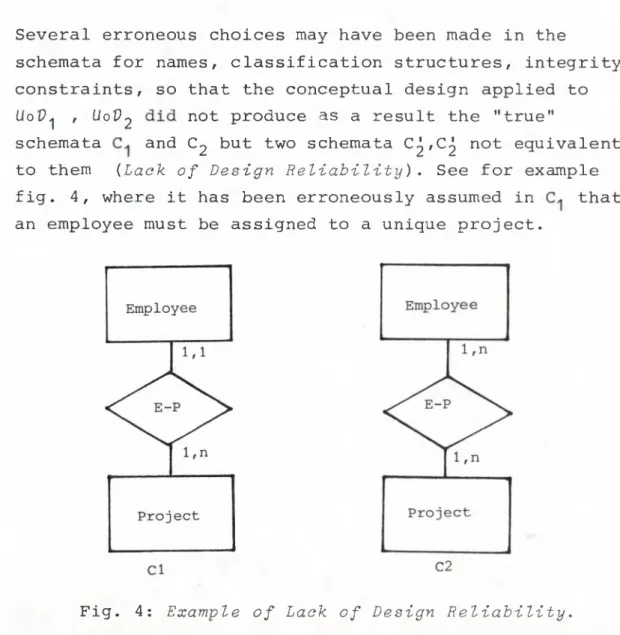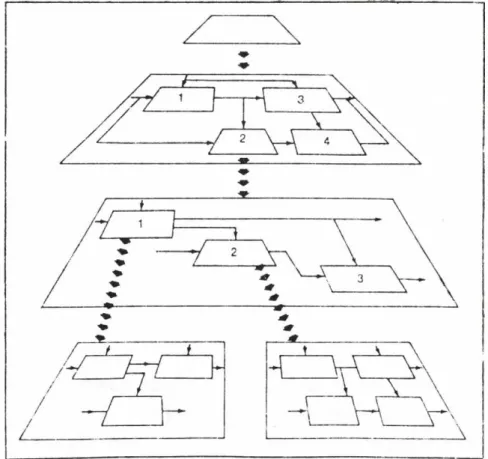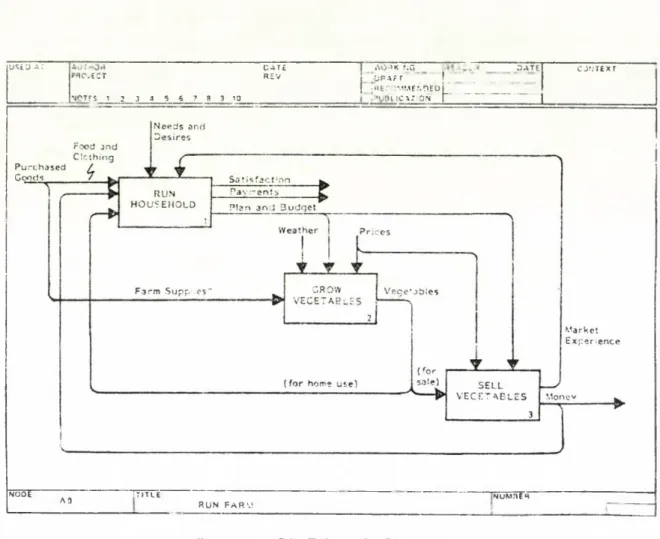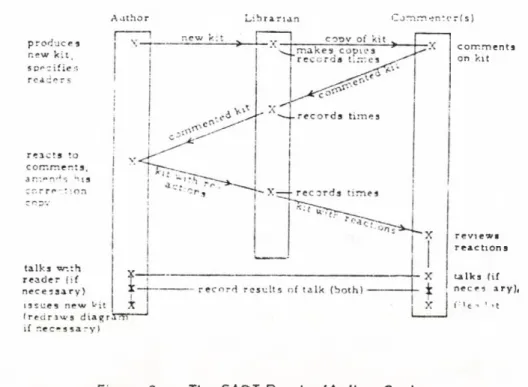COMPUTER AND AUTOMATION INSTITUTE HUNGARIAN ACADEMY OF SCIENCES
IFIP T C . 2 W O R K I N G C O N F E R E N C E
"S
ystemD
escriptionM
ethodologies"
May 22-27. 1983 Kecskemét, Hungary
Tanulmányok 150/1983
A kiadásért felelős DR VÁMOS TIBOR
Szerkesztette:
KNUTH ELŐD
ISBN 963 311 164 1 ISSN 0324-2951
C O N T E N T
Page B. LUNDBERG: On relative strength of information model 5 M. DE BLAS I, G. TURCO: Methodology for the representation
of software production processes ... 21 U. SCHMIDT, R. VÖLLER: The Development of a Machine
Independent Multi Language Compiler System Applying
the Vienna Development Method ... 51 B. HOLTKAMP, H. KAESTNER: A System Model for Vertical
and Orthogonal Migration ... 71 j. DIEZ: Towards an Information System Development
Environment ... 95 R.E.A. MASON: Concrete Use of Abstract Development
Formalisms ... 95 C. BAT IN I, M. LEN ZER IN I : A Conceptual Foundation for
View Integration ... 109
M. LISSANDRE, P. LAGIER, A. SKALLI: SAS - A Specification Support System ... 241 M. MAIOCCHI: The Use of Petri Nets in Requirements and
Functional Specification ...1 6 7
H. EVEKING: Nonprocedural Specifications of Hardware 189 I. BALBIN, P.C. POOLE, C.J. STUART: On the Specification
and Manipulation of Forms ... 213 J. A. STANKOVIC: A Technique to Identify Implicit
Information Associated with Modified Code ... 227 R.J. THOMAS, J.A. KIRKHAM: MICRO-PSL and the Teaching of
Systems Analysis and Design ... 259 G. DAVIDj W. GRAETSCH: A Hierarchical System Model for
Vertical Migration ... .
P a g e
H. KLEINE: Methodology for System Description Using
»
the Software Design & Documentation Language ... 285 V.H. HAASE: Modular Design of Real-Time Systems ... 329 S. MACHOVÁ, B. MINIBERGER: Description of Decision
Tables by PSL/PSA ... 347 S. MAC HOVÁ: PSL/PSA - A Methodological Tool for T.he -
saurus Creation ... 359
ON RELATIVE STRENGTH OF INFORMATION MODELS Bengt Lundberg
SYSLAB
Department of Information Processing and Computer Science
University of Stockholm S-106 91 Stockholm, Sweden
Abstract:
The concept of information model is since long employed to denote a representation of abstract knowledge about a perceived portion of the real world. When an information model is constructed it is changed (refined) in order to be an as precise as possible description of the considered portion of the real world.
In the paper the changes applied to an information model are discussed and analyzed from a formal point of view.
Thereby, it is assumed that an information model is represented in a first-order predicate logic language.
Within the framework given by predicate logic the relative strength of information models, and of the constructs constituting them, are discussed and examplified. Further, it is shown that an assumption of the existence of instances of the employed predicates can be useful, and practical, in order to find incorrectnesses. It follows, in particular, that it is important to represent implicit assumptions explicitly.
This work is supported by the National Swedish Board for Technical Development (STU)
6
1. INTRODUCTION
The area of information modelling, or conceptual modelling, has been the objective of intense research during the last decade. A number of approaches to
information modelling and, in particular, formalisms for the representation of information models have been presented, e.g. (Sen-77, Hou-79, Bub-80). During the last years first-order predicate logic has been employed as the basis for the analysis of formalisms of information models, but also as a representational formalism, e.g.
(Bub-80, Rei-81, Lun-82a). In this paper we discuss and analyze from a formal point of view the process of changing an information model aiming at a more precise (or, stronger) information model with respect to an assumed universe of discourse.
The relative strength of information models, and the constructs within them, are discussed. Further, it suggests that an information model should be made as complete as possible, in particular, implict assumptions should be made explicit. Also, an existence assumption is introduced and discussed with particular attention to its application to information modelling.
2. THE CONCEPT OF INFORMATION MODEL
When a portion of the real world, usually called a universe of discourse (ISO-82), is considered, two types of knowledge about it can be identified, namely: concrete knowledge and abstract (or, general) knowledge. With concrete knowledge is meant such knowledge that refers to states-of-affairs in the universe of discourse, e.g. "Jim earns 1000". With abstract knowledge is meant such knowledge that refers to conditions holding for types of states-of-affairs, e.g. "all employees have a salary".
An information model is defined to be a representation of abstract knowledge about a universe of discourse. Thus, representations of concrete knowledge is not considered.
When referring to a universe of discourse the intension is to refer to the structural properties of the perceived states of the real world, i.e. a particular set of entities is not assumed in the real world.
In what follows we will assume that an information model is represented in a first-order predicate logic language.
This inplies that an information model is constituted by a number of first-order sentences which are the non- logical axioms of a first-order theory for which the universe of discourse is a set of models. Further, it is
7
assumed that the identity relation holds in the universe of discourse, i.e. we have theories with equality. This implies that function symbols and individual constants are dispensible, i.e. the only non-logical symbols of an information model are the predicate symbols.
3. DEVELOPMENT OF AN INFORMATION MODEL
When an information model is constructed for a universe of discourse two principal strategies can be applied:
a) define the types of state-of-affairs that are considered, i.e. define the employed predicate symbols, and then declare sentences reflecting abstract knowledge in the defined language.
b) start with a part of the universe of discourse and define the language for it and represent the abstract knowledge about it, then extend the language of the information model and the set of sentences.
This can be represented graphically as follows:
number of
sentences final information
Figure 1
Strategy b is the more practical strategy, but from a theoretical point of view the interesting strategy is
8
strategy a. Further, strategy b can be reduced to strategy a by considering it as an interactive procedure that extends the language of the information model and adds sentences the information model. When the information models is constructed it is assumed that its sentences are true (satisfied) in the universe of discoulp. This immediately implies that the information model is consistent as it has a model. The final
information model is also assumed to have the properties that it is finite and that all perceived abstract knowledge about the universe of discourse is represented.
4. CHANGING AN INFORMATION MODEL
Assume that a partial information model 01 is obtained, which is changed and another one 02, is then obtained.
Four types of changes can be considered:
- a predicate symbol is added - a predicate symbol is excluded
- a sentence is added (without changing the language) - a sentence is excluded (without changing the language) As pointed out above we assume that the information model 01 is satisfied in the considered universe of discourse.
4.1 Addition of a predicate symbol
When a predicate symbol is added to the language of the information model this will have no formal implications on the information model. However, from the point of interpretation it implies that a type of states-of- affairs is considered in the "new" information model 02 that was not considered in 01. In order to only represent the implied extension of the universe of discourse of the information model a tautological sentence can be added.
Example: Assume that also employees are considered in the universe of discourse, then the tautological sentence
Vx(emp(x) — > emp(x)) can be added.
An addition of tautological sentences to an information model adds no knowledge to it as a tautological sentence
is satisfied in all universes of discourse.
9
4.2 Exclusion of predicate symbols.
When a predicate symbol of an information model is excluded it implies that a type of state-of-affairs in the universe of discourse is disconsidered. When a predicate symbol is excluded from the information model also those sentences that include the excluded predicate symbol must be excluded, or changed. Then three cases can occur:
a) tautological sentences are excluded, this will not influence the remaining information model (cf. above).
b) sentences defined over the excluded predicate symbol only are excluded, neither this case will influence the remaining information model as the sentences are independent of the rest of the sentences. The resulting information model is satisfied in the universe of discourse but can become less informative than the original information model (see also section 4.4.) .
c) sentences including the excluded predicate symbol are exluded. This case will be discussed in section 4.4.
4.3 Addition of sentences.
When a sentence e is added to an information model 01, giving 02, three cases can occur (cf. Lun-82b).
a) It holds that -e is deducible from 01
This means that if e is added to 01, the extended information model, 02, is inconsistent. This implies that 02 is not satisfied in any universe of discourse and in particular not in the considered one.
b) It holds that e is deducible from 01
Due to the soundness theorem for predicate logic this implies that the sentence e is satisfied in all models that satisfy 01, thus no additional knowledge is represented in 02 relative 01 and, thus, the sentence e is redundant in 02.
c) Neither e nor -e is deducible from 01
In this case the "new" information model 02 will be more informative than 01. But, this does not imply that it really exist a model for 02 that does not satisfy 01. This latter case will occur as soon as we have an information model that is not complete, e.g.
when natural members are considered in the universe of discourse.
10
4.4 Exclusion of a sentence
Assuming that the information model 01 is satisfied in the universe of discourse and a sentence e is excluded then it can occur that 02 is less informative than 01.
This follows directly as whenever 01 is satisfied in the universe of discourse so are all of its sentences and if one sentence is excluded the rest of sentences are still satisfied in the universe of discourse (cf. section 4.2).
However, if the excluded sentence e is not deducible from 02, then 02 will be less informative than 01, i.e. e is not redundant in 01.
4.5. Discussion.
The main information correctness information correctness
problem concerning the representation of models in predicate logic is that of checking. Assuming that the sentences of an model are syntactical correct the only criterion that can be applied is that of consistency. As we have pointed out above the consistency of an information model can be violated only when a sentence is added to it. For example, assume that a sentence is added to an information model and that the sentence does not violate the consistency. In such a case no formal criterion of correctness of the sentence with respect to the other sentences is available.
Example: Assume that obtained:
the following information model is Vx(secretary(x) -> emp(x))
and assume that the following sentence is added Vx(seeretary(x) -> emp(x) V board-member(x))
for the resulting information model it holds:
the information model is consistent
the second sentence is deducible from the the first sentence
But, should the second sentence replace the first sentence?
In order to increase the capability of determining the resulting information model after a change we have to find suitable meta-rules which can support a user when a model is changed. Consider the above example, in such a
11
case one could apply a rule saying that whenever the sentences include the same predicates then the sentences have to be intuitively inspected for correctness (i.e.
with respect to the considered universe of discourse).
However, such principles are outside the formal processing of information models.
5. RELATIVE STRENGHT OF INFORMATION MODEL
In what follows we will assume that the language of two information models, 01 and 02, are identical, i.e. they are defined over the same predicate symbols.
The information models are said to be equivalent, written 01=02, if it holds for any sentence e that
01 h e if and only if 02 h e
Further, we say that 02 is (deductively) stronger, or more informative, than 01, written 01>>02, if for some sentence e it holds-that
02 h e and not 01 h e
We also say that an information model 0 is optimal if it does not exist a sentence e reflecting perceived abstract knowledge such that
not 0 h e
This should not be confused with the stronger concept of completeness of theories. Only for very simle cases it is possible to arrive at a complete theory (information model) and that is the reason for the weaker concept of optimality which refers to the perceived abstract knowledge. A theory is said to be monomorphic if it is consistent and all its models are isomorphic to each other, thus a monomorphic theory specifies all of the structural properties of its possible models (Car-54).
Further, an information model 0 is said to be non- redundant if for any sentence e in 0 it does not hold that e is deducible from 0 - {ej .
6. APPLICATIONS TO INFORMATION MODELS
In this chapter we will analyze and discuss some examples of constructs in information models with respect to their relative strength and its implications on the strenght of information models.
12
6.1 A simple example
Assume that we have the following concrete knowledge about a universe of discourse:
"Jim owns EMM300"
"John owns EUJ399"
"Jim owns LA6880"
An initial information model 01 is constructed:
0 1 = (vxVyVzVuVv(own(x,y) & own(x,z) & own(x,u) & own(x,v) (y=z) V (y=u) V (y=v) V (z=u) V (z=v) V (u=v)
)J
Then a sentence e is added to 01, giving 02=01U fe} , where e = VxVyVzVu(own(x,y) & own(x,z) & own(x,u) — >
(y=z)
v
(y=u)v
(z=u))The relationships that hold for 01 and 02 are:
- 0l>>02 as the sentence e can not be deduced from 01 - 02 is redundant as we can let 02= {e?
- we can say that 02 is optimal as it is assumed to reflect the perceived structural properties of the concrete knowledge above.
6.2 A typical example
Assume that we have the following abstract knowledge about a universe of discourse.
"all employees has a salary"
The predicates of the intended information model are:
exp(x) "x is an employee"
sal(x) "x is a -salary"
esal(x,y) "employee x earns the salary y"
Assume that an initial information model is 01 = [vx(emp(x) — > 3y(sal(y) & esal(x,y)))(
13
This information model can be any pair of entities to
'esal(x,y)'. Assume that a declared:
made stronger as it permits satisfy the predicate second information model is 02 = {vx(emp(x) — > y(sal(y) & esal(x,y)))
VxVy (esal (x , y) — > emp(x) & sal (y) )}
This information model is stronger than 01 as it restrics the instances for 'esal' to be pairs of entities where the first entity is an employee and the second is a salary. We say that we "close" the predicate 'esal' by the second formula. Further, the added sentence is not deducible from 01, i.e. a closing of the predicates makes the information model stronger.
The two formulae of 02 are typical instances of constructs of most approaches to information modelling.
The first formula reflects a so called totality (total function (Bub-80)) which states that all instances of a set of entities are related in a particular way to other entities. The second formula represents a so called domain declaration which states that the entities of an association type are of certain types.
6.3 Relative strength of constructs.
The information model 02 of the preceeding section is a quite typical instance of information models as it expresses properties of all the instances of a set of entities. However, it should be noted that it is not assumed that it exists either exployees, salaries or esal-associations. In the next section we will discuss a possible assumption of existence of extensions of predicates. Here we will consider some general patterns of constructs and discuss their relative strength.
In most basic textbooks on predicate logic four basic constructs are presented and discussed; they are of the types:
Vx(trucker(x) 3x (trucker (x) Vx (trucker(x)
3x(trucker(x)
— > employee(x))
& employee(x))
& employee(x))
— > employee(x)) The first
construct.
universes
construct implies the fourth, which is a The fourth construct is satisfied in of discourse except those in which, e.g exists truckers and all of them are not employees.
weak all , it This
14
type of construct will cases. The third type of states something about discourse, which probably cases. Of more interest and second types.
hardly be useful in practical construct is very strong as it
all entities in the universe of will be to strong in practical are the constructs of the first First of all, we have to point out that the
formulae above are incomparable in that neither are deducible from the other.
two first of them Let us consider the first formula, which states something about the instances of a set of entities. This type of construct has earlier been used in several approaches to information modelling. Examples are the totality constructs and domain declarations, which were discussed
in section 6.2.
An alternative of the general pattern of the first formula is:
Vx (secretary(x) V trucker(x) — > employee(x)) This formula is stronger than, say
Vx (secretary(x) — > employee(x))
as the former states that those who are secretaries or truckers are employees and the latter states that secretaries are employees. Further, the former formula is reducible into
Vx (secretary(x) — > employees(x)) Vx (trucker(x) — > employees (x)) A weaker formula is
Vx (secretary(x) & trucker (x) — > employee(x))
which states that those who are both secretaries and truckers are employees. This formula is not reducible.
Correspondingly, we find that, e.g.
Vx (employee(x) — > secretary(x) V trucker(x)) Vx (employee(x) — > secretary(x) & trucker(x)) are weaker respectively stronger than, say Vx (employee(x) — > seeretary(x))
15
which is one of reductions of the implication with a conjunction in the consequent.
From these examples we conclude that in practical cases we should identify abstract knowledge that holds for as large as possible sets of entities and for which as many as possible properties hold. In particular, we have to
"close" the predicates as much as possible (cf. section 6.5.) .
Now, let us consider the second type of constructs. The basic construct is, say,
3x (secretary(x))
This construct is of course weaker than 3x (secretary(x) & trucker (x))
as the latter states that it exists an entity that is both a secretary and a trucker. A weaker formula is, say, 3x(secretary(x) V 'trucker(x))
which states that is exists an entity that is a secretary or a trucker.
From these examples we conclude that one should if possible state that it exists entities which have a combination of properties. This is still more obvious if we combine the principal types of constructs, e.g.
Vx(seeretary(x) — > employee(x)) Sx (secretary(x) )
The first formula does not imply the existence of a secretary and then not the existence of an employee. If the second formula is also declared in an information model it immediately follows that it also exists employees.
6.4 Discussion on an existence assumption.
In the preceeding section we pointed out that one should if possible declare in an information model that it exists entities with certain properties. In this section we will discuss the implications of an assumption which states that every predicate has an instance. One can easily identify arguments supporting such an assumption, but also arguments against it.
16
An argument supporting the existence assumption is:
- when an predicate including discourse to by the
information model is constructed and a symbol is employed it exists a reason for the predicate symbol, i.e. in the universe of it exists state-of-affairs which are referred predicate symbol.
However, a universe of discourse refers to a number of states of a portion of the real world and the existence assumption would then imply that in every state it exists an instance of the predicate symbols. This argument can easily be refused by assuming that the predicates include a variable which refers to states. Then, the existence assumption would be restated to: "it exists a state such that it exists ...". But, this is only a reduction of the problem and the same argument holds against the existence assumption in this case. Thus, we conclude that from a pure theoretical point of view an existence assumption should not be made. But, from a practical point of view it should be made as long as its advantages and disadvantages are considered.
Let us illustrate the advantage of the existence assumption by an example:
Assume that the following abstract knowledge holds for a universe of discourse:
"all who has a salary are employees"
"nobody is both an employee and a shareholder"
"every shareholder has a salary".
This is represented as follows:
VxVy(esal(x,y) — > emp(x)) - 3 x (emp (x) & sh (x) )
Vx(sh (x) — > 3 y (esal(x,y)))
This set of formulae is consistent. However, from intuitive considerations it is concluded that it must be inconsistent. But, this is due to the implicit assumption that it really exists a shareholder. If this is assumed and included among the formulae above we will immediately have an inconsistent set of formulae. Thus, in this case the existence assumption is advantegous.
The following examples shows that one has to be aware of the disadvantages of the existence assumption. Assume that for a universe of discourse the following abstract knowledge holds:
17
"if there is a secretary there are no truckers"
"if there is a trucker there are no secretaries"
This is represented as follows:
3x(secretary(x)) — > Vx(-trucker(x))
This formula is consistent. If the existence assumption is made then we have to add the following formulae:
Jx3y (secretary (x) & trucker (y) )
Then, the extended set of formulae will immediately become inconsistent as the only universe of discourse that satisfies the original sentences is that in which all entities are secretaries or all entities are truckers, i.e. either of the sets of entities must be empty. Thus, in this case it was a disadvantage to assume the existence of an instance of the predicates.
However, the above case can be easily avoided by making the idea of states of the universe of discourse explicit.
The abstract knowledge can then be restated as follows
"if there is a trucker"
secretary in a state then there is no which is represented as follows
Vx (3y (secretary (y,x) ) -> Vy (-trucker (y,x)) ) and the existence assumption gives
3x3y3z 3u (secretary(x,y) & trucker(z,u))
With this approach we avoid an inconsistency of the information model.
From a practical point of view we conclude that the existence assumption is advantageous as:
- it makes the information model stronger, (cf. section
6.3)
- it makes it more probable to find an inconsistency (cf.
above)
- existence of entities are usually assumed in every-day reasoning (cf. above)
18
However, we have to be careful with the existence assumption when, as above, disjoint sets of entities are considered and, in particular, as in the last example, mutually exclusive sets of entities are considered.
6.5 Closing an information model
In section 6.2 we introduced the idea of closing a predicate which was examplified by a so called domain declaration, e.g.
VxVy(esal(x,y) — > emp(x) & sal(y))
The formula states, e.g., that those objects that have a salary are employees. However, this is all that the formula represents. When such a formula is represented in an information model it is usually implicitly assumed that the objects that have a salary are employees, and are of no other types, such as shareholders. In order to obtain a stronger information model we should also state, if possible in the actual case, that the objects that have salaries are not also shareholders. This means that it should be stated both what "holds" and what "does not hold" for a set of entities. Thus, we can complete the above formula with the following:
-3x3y(esal(x,y) & shareholder (x) ) which is equivalent to
VxVy(esal(x,y) — > - shareholder(x))
However, this is not equivalent with that the sets of employees and shareholders are disjoint as an entity can be an employee who does not have a salary.
The idea of closing the predicates of an information model is quite similar to the closed world assumption of data bases, cf. (Rei-81). In our context the assumption implies, in principle, that an information model can be made complete (in the logical sense). However, as we pointed out above, we can not expect an information model to be complete (cf. chapter 5), but there are good reasons for aiming at "complete" (or, optional) information models:
- an information model becomes stronger - implicit assumptions are made explicit.
These arguments imply that correctness checking of an information model will be more efficient, in particular consistency checking (cf. section 6.4).
19
7. CONCLUSIONS
In this paper we have focused on the process of changing an information model in order to obtain an information model that is as precise as possible with respect to the considered universe of discourse. Some principles to be applied in the construction of information models in order to obtain the above goal are presented. These principles include that the employed predicate symbols of an information model should be "closed" such that their instances are completely characterized. Further, it is proposed that an existence assumption about instances of
the predicates should be made, though it has a limitation, which is pointed out. The relative strength of some typical constructs of information models are also discussed and examplified.
R E F E R E N C E S
Bub
Car
Hou-
Iso-
.Lun-
Lun-
Rei- Sen-
80 Bubenko, Janis, jr.: "Information modeling in the context of system development", IFIP-80, Tokyo, Japan, 1980.
54 Carnap, R.: "Einfurung in die symbolische Logik, mit besonderer Berücksichtigung ihrer Anwendung", Wien, Austria, 1954.
79 Housel, B.C., Waddle, V., Yao, S.B.: "The functional dependency model for logical database design", IBM Res.Lab., San Jose, USA, 1979.
82 Griethuysen, J.J. (ed): "Concepts and Termino
logy for the Conceptual Schema and the Informa
tion Base", ISO TC97/SC5/WG3, 1982.
82a Lundberg, B.: Contributions to Information Modelling, Ph.D.-thesis, Stockholm, Sweden,
1982.
82b Lundberg, B.: "IMT - an Information Modelling Tool", IFIP WG 8.1 Work.Conf. on Automated Tools for Information Systems Design and Development, New Orleans, USA, 1982.
81 Reiter, R.: "Data Bases: A logical perspec
tive", SIGMOD, Vol 11:2, 1981.
77 Senko, M.E.: "Conceptual schemas, abstract data structures, enterprise descriptions", Internat.
Comp. Symp., 1977.
METHODOLOGY FOR THE REPRESENTATION OF SOFTWARE PRODUCTION PROCESSES
M. De Blast and G. Turco
Istituto di Scienze dell'Informazione , Universita' dl Bari, Italy
1.INTRODUCTION
Software production processes are measurable entities, as are software products themselves. They also include software products, but their essential components are production activities. In this study,
"production activity" is taken to mean the sum total of manual and automatic operations required to pass from one product to another.
Among production activities, even the measurements are to be
22
considered. In this case, two levels of analysis are established: the first refers to the object to which the measurement activity is applied and the other to the activity itself.
The production process is an entity in development, not terminated as on the contrary is a software product. The analysis of a production process is directed towards the knowledge of objects which must still be produced, with the aim of influencing production mechanisms themselves.
Elshoff /1 / uses complexity as a control variable in the production process: the programmers are constantly supplied with feedback on the code which they are producing, so that when it becomes too complex, they are asked to reprogram it until values of acceptable complexity are obtained.
Belady and Lehman /2/ see the large software systems as organisms which change during their lifetime in relation to their environment.
We maintain the necessity of intensifying the interactions with the environment during the initial stages and decreasing them after the product has been released. This may be done by means of measurements, as in Elshoff, which generate a feedback on the process itself.
The analysis of production processes must have previsional characteristics in relation to the product to be obtained. De Miliő and Lipton /3/ suggest that ideas should be taken from less precise sciences than Physics -for example Meteorology or Economics-, since in these, as in Software Science, the predictive component is much more important than the explanatory one.
The summary of the Panel Findings of /4/ states that: "A natural
23
dichotomy exists in the interests of those who study software metrics.
There are those whose interests lie in studies of the creation and management of programs - in human performance. And there are those whose interests lie in studies of the object produced - in program performance.
Although it is generally agreed that there ought to be a natural relationship between these two types of studies, we see no unifying theory developing in the near future".
So, software products and production processes should be represented in the same space and analytical relations between the former and the latter should be established.
Belady /5/ also maintains that it is difficult to develop a metric for both products and processes. Many experiments (see for example Sayward /6/) have been conducted to measure products and few to measure processes. Sayward also reports various experiments which relate the two areas. However, these suffer from the lack of a unifying theory based on a univocal product and production process representation.
This study introduces a definition space for production processes.
In this space, a production process corresponds to a trajectory made up of segments representing the activities. The final and intermediate points correspond to the various products obtained during the entire process. Or else they may be isolated from the trajectory in order to represent products which already exist, and can be used in the production process.
Section 2 deals with the definition space of software production processes.
24
In the Sections following, the representation of processes and products in this spa<^, its metric basis and usage of analytical relations as previsional and comparing tools, are developed.
An application of the methodology is carried out on some production processes studied in a preceeding paper /7/.
The tools for production process measurement, introduced in /7/, are described in detail in /8/, where a presentation is made of an application in an industrial environment of the methodology proposed for the production of large scale software.
2. DEFINITION SPACE OF SOFTWARE PRODUCTION PROCESSES
A software production process can be represented by a trajectory of a point moving through a space, whose coordinates are measurable properties such as: production time, programming cost, functional requirements, execution time, memory occupation, level of portability, maintenance level, readability, complexity, etc.
According to the production tools available (hardware and software) and the preselected strategies, we will have various trajectories and various arrival points of these trajectories. The choice of which trajectory to follow should take into account those arrival points found within a predetermined area of the definition space ( "area of acceptability" )
25
Intermediate points may also influence the choice of optimum trajectory. Assuming that time is a privileged variable, it may be interesting, for example, to determine trajectories which connect products, P(t), obtained at different times, ti and tf, with equal functional characteristics, but with different performances, whose final points, P(tf), are of course still within the area of acceptability ("prototyping" and "tuning").
In certain cases, it may be preferable to follow this kind of trajectory, instead of one which has a final point with greater characteristics, but no intermediate points of the type described. In fact, in this way, we have the advantage that, from the first phases of software generation, a product is already obtained with the required functionality, even if the other prerequisites are not yet satisfied.
This is useful for testing and evaluation purposes.
Groups of variables in this space may be part of particular metric bases, according to which aspects of product or production process are enphasized in the analysis. Among the most important, we indicate the well-known metrics based on the analysis of the program text (Halstead /9/) and those, complementary to them, which are based on its history of execution (Knuth /10/).
The software product continues its trajectory even after what we have called its arrival point. Actually it is at this point that it begins to exist as a "finished product". From this moment on, other variables become important, specifically: costs of maintenance, transport if any, modification, extension, error elimination, execution time,
26
occupation of memory and of other resources.
It is essential that the entire trajectory, and not only the point determining the final product, is situated, from this moment onward, in an area of acceptability, in order to ensure that the quality requirements, whether set or forecast, will be constantly satisfied.
Many quantities possess this double aspect which refers to "before"
and "after" the product has been obtained. That is, there is one cost for preventive therapy and one for the intervention on the product. For example, Jones /11/ separates quality measurements into measures of defect removal efficiency and defect prevention.
Thus, the conclusion reached is that the trajectory should be chosen according to the arrival point of the product and the intermediate points, and also according to "future" points. How to choose a trajectory on the basis of measurements of a product which still must begin to exist, is a problem which, within other sciences, is solved in two possible ways:
a) making use of simulators which, by underlining determined characteristics each time, also allow their measurement and thus the evaluation and choice of the trajectory which optimizes that partial set of characteristics;
b) determining other variables, from which "future" variables may be deduced by means of analytical relations. This is equivalent to increasing the dimensions of the definition space, in order to incorporate these new and fundamental coordinates.
Both methods must generate 1) an adequate instrumentation for the
27
measurements of the quantities of interest, and 2) a set of analytical relations and/or invariance principles for the interpretation of measurements carried out. The difference between the two methods lies in
the varying importance assumed by the two above mentioned points.
Each time one proceeds towards such a modelization, introducing groups of variables characterizing each aspect of a software product or of a production process, with tools for their measurements and analytical relations for their interpretation, a definition is made of a "Physics"
or, better still, of a branch of Software Physics.
Returning to the concept of a trajectory in a definition space of software products, it is worthwhile focusing attention, for a moment, on particular types of trajectories: those which join two points of two distinct trajectories, as in the conversion of a product from one computer to another.
In this operation, the most obvious variable is the cost of transport, which may vary to a great extent, according to the level of portability of the original software. Moreover, if this is not portable, there are two groups of trajectories, whether or not the arrival product is portable, thus causing a notable difference in transport cost. The importance of this variable is so great as to wrongly overshadow other factors such as: time efficiency, memory occupation, level of maintainability, etc., thus limiting us to a simple maintenance or generic improvement of values assumed in the original product. Also in this case, a physical approach cannot avoid the examination and measurement of all variables on which software product trajectories
28
depend, so as to forecast the characteristics and performance of the final product, thereby carrying out the choice of the trajectory which achieves the best compromise.
Tools used in the software production, such as languages, compilers, interpreters, code generators and operating systems, are software products as well. The characteristics of products to develop and thus the various trajectories are dependent on them. Generally, software production tools correspond to isolated points in space, since they are almost always products already obtained, supplied by the firm or by an external software manufacturer.
In other cases, production tools correspond to final trajectory points, if it is the user who must produce them. Testing and debugging tools and precompilers, are examples appearing in this category.
Generally, we may safely say that the measurement tools themselves are to be measured and evaluated in the production space.
Furthermore, it is often the case that, even if products supplied by an outside manufacturer are involved, they lack evaluation in terms of even such basic figures as execution time and the like, so that, in order to carry out our analysis, it is necessary to have the proper measurement tool available for these products as well.
As far as the analytical relations existing between production process variables are concerned, we have already seen their previsional properties with regard to characteristics of products still to be obtained. We have also insisted on the importance of comparing the various trajectories with one another, not only on the basis of puntiform
29
characteristics, but also of continuous intervals of the variables. Thus, it is important not only to obtain analytical relations between the variables of a production process, that is, relations along a single trajectory, but also to obtain analytical relations between the trajectories, eventually taking one of them as a trajectory of reference and relating the others to it.
3. MODELS
As examples of software production processes, we take the ones studied in /7/. The following is a brief description of the corresponding models.
Hypotheses made in /7/ on the environment included:
the existence of three language levels: HLL (High Level Language), ILL (Intermediate Level Language) and DEL (Directly Executable Language), with no reference made to the particular languages used;
- the use of normal production tools, among which in particular there were both an interpreter and a code generator from ILL to DEL;
- the use of "tuning" methodologies.
On the basis of the above, five alternative models were formulated:
1) DEL model, consistent in the writing in DEL (or in the symbolic correspondent): it defines a machine at one level (Fig. 1.1);
2) The "interpretive" model (Fig. 1.2), which concerns the writing of
30
DEL 1) DEL model
2) Interpretive model 3) Generative model
4) Interpretive 5) Generative +tuning model +tuning model
Fig.l Software production models
31
programs HLL which, for reasons of portability, are compiled in ILL and then interpreted in DEL;
3) The "generative" model (Fig. 1.3), which differs from the interpretive model in that it uses a code generator to pass from ILL to DEL;
4) The interpretive model with tuning (Fig. 1.4);
5) The generative model with tuning (Fig. 1.5).
Models 4 and 5 are respectively models 2 and 3 optimized in execution time. The tuning methodology is applied by measuring the critical HLL areas and substituting them with DEL code.
4. PRODUCTION TRAJECTORIES
An observation which may be made, before moving on to the application of considerations made in the preceeding Sections to models introduced, is that, in order to represent entities (activities and products) in a definition space of production processes, their metric basis should be defined. On the other hand, this metric may only be deduced by analysis of activities involved in the different production processes, so that it is preferable to follow the order of first introducing the production trajectories - referring to "production time"
- and then, in the following Sections, the coordinates and analytical relations essential for their analysis.
Some definitions are given and then "elementary" trajectories are
32
introduced.
A trajectory, within the definition space, is composed, as has already been stated, of segments and vertices: the former indicating production activities and the latter, the products. A segment always goes from one product to another, or rather always joins two vertices. The first segment also begins from a "product", supplied by the sum total of the initial unformalized specifications of the product to be obtained.
We shall follow the convention of labelling only the vertices - not necessarily all of them - , reporting, for the sake of brevity, the languages in which the products are obtained.
The first kind of trajectory that we shall consider, concerns measurement activities. Let us take, for example, the activity of counting n , the number of instructions executed in a given DEL program run. The corresponding diagram is shown in Fig. 2. It represents a measurement activity which leads to the passage from DEL product to DEL:n product.
The two usual ways of carrying out measurement, using instrumentation or interpretation, are represented respectively in Fig.3 and in Fig.4.
Interpretation activities are denoted by dashed segments, in order to indicate the fact that they are not activities of transformation from one product to another, but rather of execution of a product on a machine whose language is expressed by the second vertex. The measurement of n in Fig.4 is seen as a minor variation in the interpretation activity.
Another kind of trajectory is found in "conversion" diagrams, which
DEL: Kl Fig.2 Measurement trajectory of n
DEL
DELS
DEL
Fig.3 Measurement of n by means of DEL instrumentation
«
DEL
Fig.4 Measurement of
DEL:*.
n by means of interpretation
Fig.5 Diagram of conversion from machine D to machine G
Fig.6 Diagram of conversion of a DELa product to a DELb machine, examining five different production processes, leading to products all functionally identical.
34
lead to the passage from a trajectory to one or more different trajectories. An example of a conversion diagram is supplied in Fig.5, which represents the case of two products, functionally identical, but implemented on different machines. In this case, the two processes share only the initial analysis activity, while they diverge in the final production activities.
In a more general way, conversion diagrams may be interpreted as the representation of altenative production processes obtaining functionally identical products. Such processes may have some sections in common, in both the initial and final parts, supplying different products in one case and the same product in the other. The diversification of final products does not necessarily mean the use of different machines, but much more often different procedures making use of the same hardware.
A problem of conversion from a DELa to a DELb machine, which examines various alternatives, such as those outlined in the preceeding Section, may be represented schematically as in Fig.6.
The sum total of initial activities, common to the various trajectories, has no influence on the relative evaluation of the various production processes. Thus, this evaluation may include the production process followed to obtain the product to be transported, or else it may be limited only to alternative processes.
In any case, the diagram of conversion is transformed into one of
"selection" between various independent alternatives. Fig.7 traces the selection diagram for the five models introduced in the preceeding
35
Section, and Tab.l lists the corresponding products.
(1) DEL writing. Reference trajectory.
Hll
(2) HLL writing, ILL compilation, interpretation.
HLL
(3) HLL writing, ILL compilation, DEL code generation.
Fig.7 Production trajectories for: 1) DEL, 2) Interpretive, and 3) Generative models.
